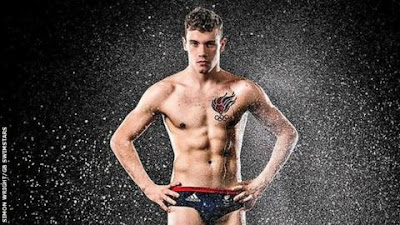Bunks appeared on Disney XD Canada in 2013, but has just made it to Netflix. It stars teen idols Dylan Schmid (left) and Aiden Shipley (below) as troublemaking brothers Dylan and Dane masquerading as counselors at Camp Bushwack.
They are assigned a cabin of non-athletic, intellectual, bullied boys who they bond with,
Meatballs-style.
There is a
Revenge of the Nerds-style competition with the Golden Boy cabin.
Plus there is a book of urban legends that come to life when you read them. I don't remember which movie or tv show had this plotline. Maybe
Are You Afraid of the Dark?
They accidentally read a story about zombies, who begin to lumber about,
Walking Dead-style, infecting counselors, until they are cured by either an electronic slave collar or a dose of orange juice.
The zombie-camper battle effectively resolves the other plotlines.
Sounds like a terrible pastiche, but somehow it manages to work.
Especially for gay viewers:
1. Hetero-romance is minimal. Dylan briefly chats with someone who I expected to become The Girl, the goal of his journey,but no romance occurred. The nerd campers discuss going to visit the cheerleaders in the camp next door, a plan which Dane fully approves of.
And that's it. The main pair is definitely Dylan and Dane.
2. There are no shirtless scenes in the movie itself, but most of the counselors are played by very cute actors who have spent last five years taking their shirts off.
Dylan Schmid has starred in
Shuteye and
Beyond.
Aiden Shipley has appeared in
Clusterf*k and
Edging (which is not about what you think).
Chief zombie Atticus Mitchell (left), known for
My Babysitter is a Vampire on the Disney Channel, has also appeared in
Young Drunk Punks, Stonewall, and
Killjoys
Markian Tarasiuk, who plays the rival counselor, has appeared in
The Magicians, Status Update, and
Shuteye


















